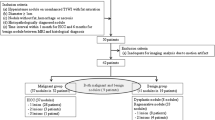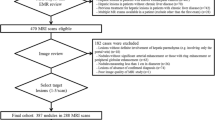Abstract
Background
To demonstrate the characteristic feature of hepatic cavernous hemangiomas on ferucarbotran-enhanced T2-weighted MR imaging as a new diagnostic finding.
Methods
In 201 hepatic lesions (61 hemangiomas, 61 cysts, 41 hepatocellular carcinomas, 31 metastatic carcinomas, and 7 cholangiocarcinomas), lesion-to-liver contrast on ferucarbotran-enhanced T2-weighted images was qualitatively compared with pre-contrast images by three independent readers using a four-grade scale (group 1, marked increase; group 2, mild increase; group 3, no change; group 4, decrease). The change in the contrast-to-noise ratio (CNR) for each lesion was quantitatively measured.
Results
Only hemangiomas showed a significant decrease in CNR; 10% and 90% of the hemangiomas were categorized as group 3 and 4 lesions, respectively. Besides the hemangiomas, there was no other lesion categorized into group 4 except for one cyst. When group 4 lesions were considered hemangiomas, the accuracy of identification was 96.4%.
Conclusion
Hemangiomas show a significant decrease in lesion-to-liver contrast on T2-weighted images after ferucarbotran injection, which might be another typical diagnostic imaging finding of hemangiomas distinguished from solid malignant lesions.





Similar content being viewed by others
References
Karhunen PJ (1986) Benign hepatic tumours and tumour like conditions in men. J Clin Patho 39:183–188
Bennett GL, Petersein A, Mayo-Smith WW et al. (2000) Addition of gadolinium chelates to heavily T2-weighted MR imaging: limited role in differentiating hepatic hemangiomas from metastases. AJR 174:477–485
Yu JS, Kim MJ, Kim KW et al. (1998) Hepatic cavernous hemangioma: sonographic patterns and speed of contrast enhancement on multiphase dynamic MR imaging. AJR 171:1021–1025
Nelson RC, Chezmar JL (1990) Diagnostic approach to hepatic hemangiomas. Radiology 176:11–13
Hanafusa K, Ohashi I, Himeno Y et al. (1995) Hepatic hemangioma: findings with two-phase CT. Radiology 196:465–469
Quinn SF, Benjamin GG (1992) Hepatic cavernous hemangiomas: simple diagnostic sign with dynamic bolus CT. Radiology 182:545–548
Gaa J, Saini S, Ferrucci JT (1991) Perfusion characteristics of hepatic cavernous hemangioma using intravenous CT angiography (IVCTA). Eur J Radiol 12:228–233
Leslie DF, Johnson CD, MacCarty RL et al. (1995) Single-pass CT of hepatic tumors: value of globular enhancement in distinguishing hemangiomas from hypervascular metastases. AJR 165:1403–1406
Bree RL, Schwab RE, Glazer GM et al. (1987) The varied appearances of hepatic cavernous hemangiomas with sonography, computed tomography, magnetic resonance imaging and scintigraphy. Radiographics 7:1153–1175
Tung GA, Vaccaro JP, Cronan JJ et al. (1994) Cavernous hemangioma of the liver: pathologic correlation with high-field MR imaging. AJR 162:1113–1117
Semelka RC, Brown ED, Ascher SM et al. (1994) Hepatic hemangiomas: a multi-institutional study of appearance on T2-weighted and serial gadolinium-enhanced gradient-echo MR images. Radiology 192:401–406
Whitney WS, Herfkens RJ, Jeffrey RB et al. (1993) Dynamic breath-hold multiplanar spoiled gradient-recalled MR imaging with gadolinium enhancement for differentiating hepatic hemangiomas from malignancies at 1.5 T. Radiology 189:863–870
Semelka RC, Shoenut JP, Kroeker MA et al. (1992) Focal liver disease: comparison of dynamic contrast-enhanced CT and T2-weighted fat-suppressed, FLASH, and dynamic gadolinium-enhanced MR imaging at 1.5 T. Radiology 184:687–694
Choi D, Kim S, Lim J et al. (2001) Preoperative detection of hepatocellular carcinoma: ferumoxides-enhanced mr imaging versus combined helical CT during arterial portography and CT hepatic arteriography. AJR 176:475–482
Kim SK, Kim SH, Lee WJ et al. (2002) Preoperative detection of hepatocellular carcinoma: ferumoxides-enhanced versus mangafodipir trisodium-enhanced MR imaging. AJR 179:741–750
Bartolozzi C, Donati F, Cioni D et al. (2004) Detection of colorectal liver metastases: a prospective multicenter trial comparing unenhanced MRI, MnDPDP-enhanced MRI, and spiral CT. Eur Radiol 14:14–20
Petersein J, Spinazzi A, Giovagnoni A et al. (2000) Focal liver lesions: evaluation of the efficacy of gadobenate dimeglumine in MR imaging–a multicenter phase III clinical study. Radiology 215:727–736
Kumano S, Murakami T, Kim T et al. (2003) Using superparamagnetic iron oxide-enhanced MRI to differentiate metastatic hepatic tumors and nonsolid benign lesions. AJR 181:1335–1339
Arbab AS, Ichikawa T, Sou H et al. (2002) Ferumoxides-enhanced double-echo T2-weighted MR imaging in differentiating metastases from nonsolid benign lesions of the liver. Radiology 225:151–158
Lee JM, Kim IH, Kwak HS et al. (2003) Detection of small hypervascular hepatocellular carcinomas in cirrhotic patients: comparison of superparamagnetic iron oxide-enhanced MR imaging with dual-phase spiral CT. Korean J Radiol 4:1–8
Kang BK, Lim JH, Kim SH et al. (2003) Preoperative depiction of hepatocellular carcinoma: ferumoxides-enhanced MR imaging versus triple-phase helical CT. Radiology 226:79–85
Grangier C, Tourniaire J, Mentha G et al. (1994) Enhancement of liver hemangiomas on T1-weighted MR SE images by superparamagnetic iron oxide particles. J Comput Assist Tomogr 18:888–896
Hahn PF, Stark DD, Weissleder R et al. (1990) Clinical application of superparamagnetic iron oxide to MR imaging of tissue perfusion in vascular liver tumors. Radiology 174:361–366
Petersein J, Saini S, Weissleder R (1996) Liver. II: Iron oxide-based reticuloendothelial contrast agents for MR imaging. Clinical review. Magn Reson Imaging Clin N Am 4:53–60
Paley MR, Mergo PJ, Torres GM et al. (2000) Characterization of focal hepatic lesions with ferumoxides-enhanced T2-weighted MR imaging. AJR 175:159–163
Denys A, Arrive L, Servois V et al. (1994) Hepatic tumors: detection and characterization at 1-T MR imaging enhanced with AMI-25. Radiology 193:665–669
Schmitz SA, Nikolova A, O’Regan D et al. (2006) Quantitative assessment of iron-oxide-enhanced magnetic resonance imaging of the liver: Vessel isointensity is a potential characteristic of liver hemangiomas on late T1-weighted images. Acta Radiol 47:634–642
Namkung S, Zech CJ, Helmberger T et al. (2007) Superparamagnetic iron oxide (SPIO)-enhanced liver MRI with ferucarbotran: efficacy for characterization of focal liver lesions. J Magn Reson Imaging 25:755–765
Vilgrain V, Boulos L, Vullierme MP et al. (2000) Imaging of atypical hemangiomas of the liver with pathologic correlation. Radiographics 20:379–397
Sherman M (2005) Diagnosis of small hepatocellular carcinoma. Hepatology 42:14–16
Bruix J, Sherman M, Llovet JM et al. (2001) Clinical management of hepatocellular carcinoma. Conclusions of the Barcelona-2000 EASL conference. European Association for the Study of the Liver. J Hepatol 35:421–430
Jang HJ, Kim TK, Lim HK et al. (2003) Hepatic hemangioma: atypical appearances on CT, MR imaging, and sonography. AJR 180:135–141
Marti-Bonmati L, Casillas C, Graells M et al. (1999) Atypical hepatic hemangiomas with intense arterial enhancement and early fading. Abdom Imaging 24:147–152
Kim S, Chung JJ, Kim MJ et al. (2000) Atypical inside-out pattern of hepatic hemangiomas. AJR 174:1571–1574
Matsushita M, Takehara Y, Nasu H et al. (2006) Atypically enhanced cavernous hemangiomas of the liver: centrifugal enhancement does not preclude the diagnosis of hepatic hemangioma. J Gastroenterol 41:1227–1230
Bartolotta TV, Taibbi A, Galia M et al. (2007) Centrifugal (inside-out) enhancement of liver hemangiomas: a possible atypical appearance on contrast-enhanced US. Eur J Radiol 64:447–455
Coumbaras M, Wendum D, Monnier-Cholley L et al. (2002) CT and MR imaging features of pathologically proven atypical giant hemangiomas of the liver. AJR 179:1457–1463
Hosokawa A, Maeda T, Tateishi U et al. (2005) Hepatic hemangioma presenting atypical radiologic findings: a case report. Radiat Med 23:371–375
Kojimahara M (1986) Ultrastructural study of hemangiomas. 4. Cavernous hemangioma of the liver. Acta Pathol Jpn 36:1477–1485
Feldman M (1958) Hemangioma of the liver; special reference to its association with cysts of the liver and pancreas. Am J Clin Pathol 29:160–162
Poeckler-Schoeniger C, Koepke J, Gueckel F et al. (1999) MRI with superparamagnetic iron oxide: efficacy in the detection and characterization of focal hepatic lesions. Magn Reson Imaging 17:383–392
Yamamoto H, Yamashita Y, Yoshimatsu S et al. (1995) MR enhancement of hepatoma by superparamagnetic iron oxide (SPIO) particles. J Comput Assist Tomogr 19:665–667
Grandin C, Van Beers BE, Robert A et al. (1995) Benign hepatocellular tumors: MRI after superparamagnetic iron oxide administration. J Comput Assist Tomogr 19:412–418
Jeong YY, Mitchell DG, Holland GA (2001) Liver lesion conspicuity: T2-weighted breath-hold fast spin-echo MR imaging before and after gadolinium enhancement–initial experience. Radiology 219:455–460
Author information
Authors and Affiliations
Corresponding author
Rights and permissions
About this article
Cite this article
Cho, ES., Yu, JS., Ahn, JH. et al. Ferucarbotran-enhanced T2-weighted magnetic resonance imaging: differentiation of hepatic cavernous hemangiomas from malignant solid lesions. Abdom Imaging 34, 494–501 (2009). https://doi.org/10.1007/s00261-008-9430-6
Published:
Issue Date:
DOI: https://doi.org/10.1007/s00261-008-9430-6




